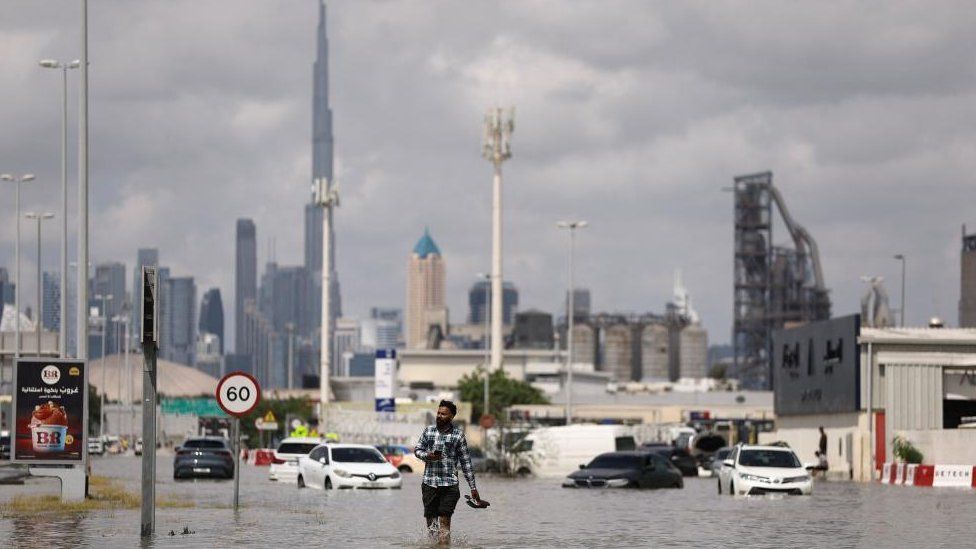 The Nepal Weekly
The Nepal Weekly  April 23, 2024
April 23, 2024
In Dubai, United Arab Emirates, the torrential downpours that took place recently left an airport submerged underwater, roads at a standstill and homes and businesses filled up with water. However, no many causality, reported in the incident so far and cost of damages is yet to be ascertained.
The glitzy city has come to standstill as a years worth of rainfall fell in 24-hours in Dubai. The torrential rain and flooding in the UAE capital in particular has submerged an airport, swamped malls and train stations and left Dubai paralysed with one person dead. With the water only just beginning to clear up, Dubai is finally getting on the move again. Billionaire businesses are desperate to reopen and recoup their losses from almost 100-hours worth of disruption but the cleanup is going to continue to take its toll for a while longer, according to experts. Insurance insiders reported the worrying prediction saying their sources have pointed to damages potentially costing up to $1billion.
This whopping figure is expected to take into account commercial damages for businesses and severe repair work needed on homes, cars and soaked stores.
It is also expected that the UAE leadership will look to pump some of their own money into flood-proofing major cities.
As they look to avoid being left swimming around for solutions in the future if another flood happens.
Speculation was rife on social media, linking cloud seeding, which involves the manipulation of existing clouds to induce rain, to the unprecedented precipitation. But experts argue the record rainfall was likely caused by climate change. Here is what we know about the reasons behind the record rainfall and subsequent flooding took place there.
The storm had initially hit Oman on Sunday before it pounded the UAE on Tuesday, knocking out power and causing flight disruptions. The deluge inundated houses, caused traffic chaos and trapped people in their homes in Dubai. By the end of Tuesday, more than 142mm (5.59 inches) had soaked Dubai. Close to 127mm (5 inches) of rain fell at Dubai International Airport, where about 76mm (3 inches) of rain is normal in an entire year.
According to authorities Oman received around 230mm (9 inches) of rain between Sunday and Wednesday. The average rainfall in the capital, Muscat is about 100mm (4 inches) per year. Bahrain, Qatar and Saudi Arabia also witnessed rains. Reports quoted meteorologists at the UAE’s National Centre for Meteorology (NCM) as saying Dubai flew six or seven cloud-seeding flights before the rains started. Flight-tracking data analysed by The Associated Press news agency also showed one aircraft affiliated with the UAE’s cloud-seeding efforts flew around the country on Monday.
Dubai situated on the coast of the UAE is usually very dry. But while it receives less than 100mm (3.9in) a year of rainfall on average, it does experience occasional extreme downpours.
In the city of Al-Ain – just over 100km (62 miles) from Dubai – about 256mm (10in) of rain was recorded in just 24 hours. A “cut off” low pressure weather system, which drew in warm, moist air and blocked other weather systems from coming through was the main cause. “This part of the world is characterised by long periods without rain and then irregular, heavy rainfall, but even so, this was a very rare rainfall event,” explains Prof Maarten Ambaum, a meteorologist at the University of Reading who has studied rainfall patterns in the Gulf region.
It is not yet possible to exactly quantify how much of a role climate change played. That requires a full scientific analysis of natural and human factors, which can take several months.
But the record rainfall is consistent with how the climate is changing. Put simply: warmer air can hold more moisture – about 7% extra for every degree Celsius – which can in turn increase the intensity of rain.
Cloud seeding involves manipulating existing clouds to help produce more rain.
This can be done by using aircraft to drop small particles (like silver iodide) into clouds. Water vapour can then condense more easily and turn into rain.
The technique has been around for decades, and the UAE has used it in recent years to help address water shortage. In the hours that followed the floods, some social media users were quick to wrongly attribute the extreme weather solely to recent cloud seeding operations in the country. Earlier reports by Bloomberg suggested cloud seeding planes were deployed on Sunday and Monday, but not on Tuesday, when the flooding occurred.
While the BBC has been unable to independently verify when cloud seeding took place, experts say that at best it would have had a minor effect on the storm and that focusing on cloud seeding is “misleading”. “Even if cloud seeding did encourage clouds around Dubai to drop water, the atmosphere would have likely been carrying more water to form clouds in the first place, because of climate change”, states an expert. Cloud seeding is generally deployed when conditions of wind, moisture and dust are insufficient to lead to rain. In the last week, forecasters had warned of a high flooding risk across the Gulf.





